Google Ads stands as the undisputed champion in online advertising for 2025. It captures an astounding 80.20% share of the pay-per-click (PPC) market, reaching billions of internet users worldwide.
Businesses that effectively use Google Ads see impressive results, often earning $2 for every $1 spent, which translates to a remarkable 200% return on investment (ROI). This powerful platform isn’t just effective; it’s absolutely essential for any business aiming to thrive online.
Imagine a world where your business reaches customers precisely when they are looking for what you offer. That’s the power of Google Ads. With 63% of users clicking on ads and Shopping Ads driving a massive 85.3% of all clicks, the platform clearly connects businesses with highly motivated buyers.
Even better, average conversion rates can soar to 9.64% in some industries, showing the incredible potential for turning clicks into actual sales.
Whether you run a startup or manage a large enterprise, the data consistently shows that Google Ads remains the most powerful tool for driving targeted traffic, increasing your online visibility, and significantly boosting conversions.
Let’s dive deep into the numbers and explore how you can leverage these insights for your business’s benefit in 2025.
Google Ads Dominance: Market Share and Reach in 2025
Google Ads has been around since 2000, starting as AdWords with simple text ads. Today, it has evolved into a sophisticated advertising ecosystem that touches almost every corner of the web. This long history and continuous innovation explain its dominant position.
1. Google Ads Market Share: The Undisputed Leader
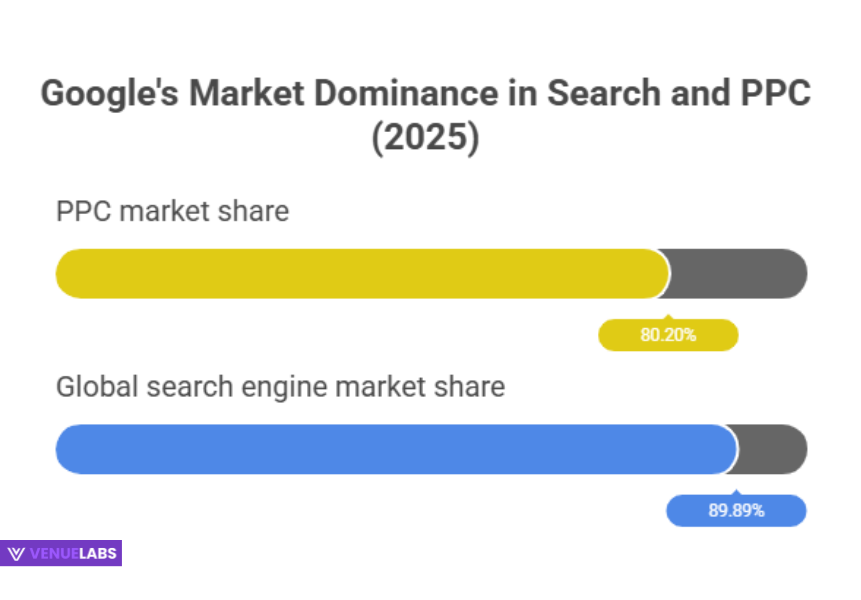
As of 2025, Google Ads commands a colossal 80.20% market share in the pay-per-click (PPC) market. This means that for every ten dollars spent on PPC advertising, more than eight dollars go to Google.
This overwhelming dominance highlights the platform’s effectiveness and its crucial role in helping businesses connect with potential customers.
Google isn’t losing ground in search either. It holds an impressive 89.89% of the global search engine market as of August 2025.
When people search online, they are almost certainly doing it on Google. This vast reach is a primary reason why businesses prioritize their ad spend here.
- Also read about: Google Searches Statistics
2. How Many Businesses Use Google Ads?
The adoption of Google Ads is widespread and continues to grow. Roughly 80% of businesses worldwide now rely on Google Ads for their PPC campaigns.
This high adoption rate underscores the platform’s proven ability to help companies attract targeted traffic, enhance their online presence, and achieve their marketing goals.
Specifically, 65% of small and mid-sized businesses actively use Google Ads for their PPC strategies, proving its accessibility and value across different business sizes.
3. Global Reach: Touching Billions
Google Ads boasts a staggering 90% worldwide reach, connecting with approximately 4.77 billion internet users. This incredible reach comes from its ability to display ads not only on Google Search but also across websites through Google AdSense, on smartphone applications, and on YouTube.
YouTube alone, the largest video-sharing platform, has 2.7 billion users, accounting for 51% of the total internet user base. When you add the billions of users across websites and apps within the Google Play Store, the potential audience size for Google Ads easily reaches multiple billions, offering unparalleled opportunities for advertisers.
Source: Statista
- Also read about: Best Google Adsense Alternatives
User Behavior: How People Interact with Google Ads
Understanding user behavior is critical for successful ad campaigns. The statistics reveal clear patterns in how people click on and engage with Google Ads.
1. Why People Click on Google Ads
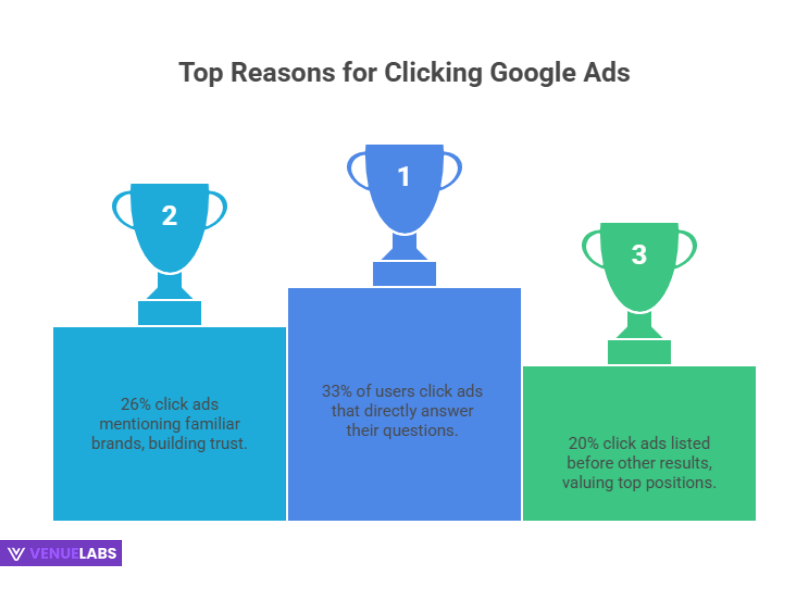
A significant 63% of people have clicked on a Google ad. This high engagement rate isn’t random; specific reasons drive these clicks:
- Answering Questions: 33% of people click on Google ads because the ads directly answer a question they have. This highlights the importance of clear, relevant ad copy that addresses user intent.
- Familiar Brands: 26% of users click on ads that mention a familiar brand. Brand recognition plays a crucial role in building trust and encouraging clicks.
- Ad Placement: 20% click on ads simply because they are listed before other results, emphasizing the value of top ad positions.
- Compelling Content: 19% are swayed by a compelling title, description, or image, showing the power of well-crafted ad creatives.
Reasons for Clicking on Paid Ads:
| Reason To Click on Paid Ads | Percentage Of People |
| Ads answer a question | 33% |
| Ads mention a familiar brand | 26% |
| Ads are listed before the other results | 20% |
| Due to a compelling title, description, or image. | 19% |
2. Click-Through Rates (CTR)
The average click-through rate (CTR) for Google Search Ads is 3.17%. However, for ads placed in the highly coveted first position, the average CTR jumps to an impressive 7.94%.
Overall, the average CTR for Google Ads across all formats is 4.6%, with the latest average recorded at 6.66%. These numbers show that higher ad positions and compelling content significantly increase the likelihood of clicks.
3. Consumer Trust and Influence
Consumer behavior research consistently shows the impact of online ads:
- Purchase Decisions: 90% of consumers report that ads influence their purchase decisions.
- Ease of Search: 75% of users find that paid search makes it easier for them to find information.
- Direct Purchases: 43% of users bought a product after seeing an ad for it.
- Millennial Influence: 58% of millennials purchased something because of an online ad.
- Online Shopping Preference: 66% of shoppers prefer to shop online.
- Trust in Ads: 41% of users reported that they trust online ads.
Interestingly, 50% of users are unaware of the difference between paid ads and organic listings. This highlights the seamless integration of ads into the search experience and their perceived credibility.
Source: eMarketer
Google Shopping Ads: A Retail Powerhouse
For e-commerce businesses, Google Shopping Ads are an absolute game-changer. They dominate the retail search landscape, driving a massive portion of clicks and spending.
Key Shopping Ad Statistics
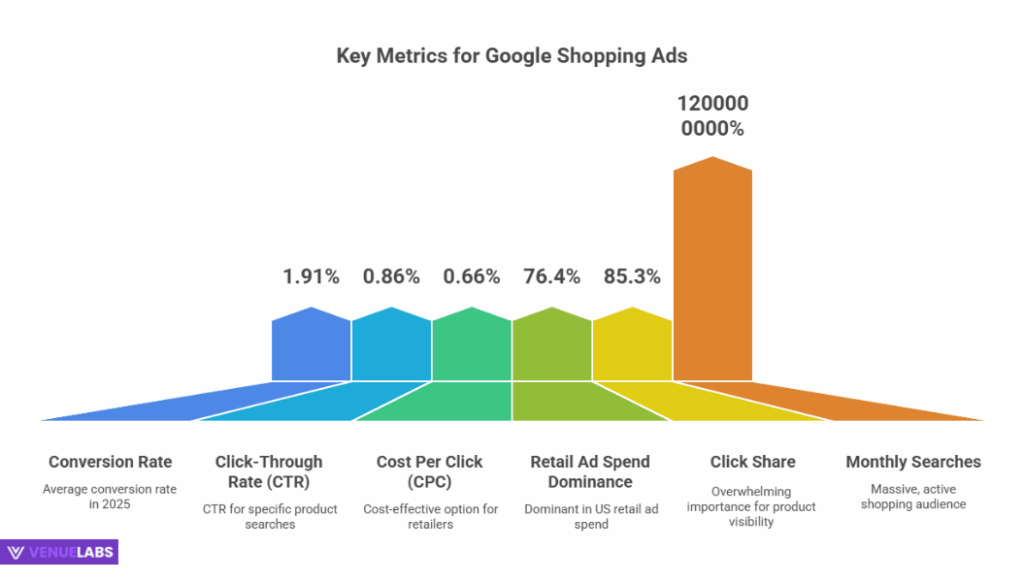
- Conversion Rate: As of 2025, Google Shopping Ads boast an average conversion rate of 1.91%.
- Click-Through Rate (CTR): The average CTR for Google Shopping Ads is 0.86%. While seemingly lower than search ads, these are often for highly specific product searches, leading to higher intent.
- Cost Per Click (CPC): The average CPC for Google Shopping Ads is $0.66, making them a cost-effective option for many retailers.
- Retail Ad Spend Dominance: Google Shopping Ads are responsible for a colossal 76.4% of all retail search ad spend in the US.
- Click Share: These ads drive 85.3% of all clicks on Google Ads and Google Shopping campaigns, showcasing their overwhelming importance for product visibility.
- Monthly Searches: Google Shop sees 1.2 billion monthly searches, indicating a massive, active shopping audience.
If you sell products, not running Shopping Ads means you are essentially handing business over to your competitors. They are crucial for capturing high-intent retail traffic.
Conversion Rates: Turning Clicks into Customers
Ultimately, the goal of advertising is to generate conversions – whether it’s a purchase, a lead, or a sign-up. Google Ads delivers impressive conversion rates across various industries.
1. Overall Conversion Performance
As of 2025, the average conversion rate for Google Ads ranges from 3.1% to 6%. This compares favorably to the average PPC conversion rate of 2.35%.
Crucially, people who click on Google Ads are 50% more likely to buy than visitors who arrive through organic search results, emphasizing the high intent of paid ad clicks.
2. Industry-Specific Conversion Rates

Conversion rates vary significantly by industry. Understanding these benchmarks helps businesses set realistic expectations and identify areas for improvement.
Google Ads Conversion Rates by Industry (2025):
| Industry | Average Conversion Rate |
| Dating & Personals | 9.64% |
| Legal | 6.98% |
| Consumer Services | 6.64% |
| Auto | 6.03% |
| Employment Services | 5.13% |
| Finance & Insurance | 5.10% |
| Travel & Hospitality | 3.55% |
| Education | 3.39% |
| Industrial Services | 3.37% |
| Health & Medical | 3.36% |
| B2B | 3.04% |
| Technology | 2.92% |
| E-Commerce | 2.81% |
| Home Goods | 2.70% |
| Real Estate | 2.47% |
| Advocacy | 1.96% |
The Dating & Personals industry sees the highest conversion rate at 9.64% for Google Search ads, followed closely by Legal and Consumer Services. Conversely, Advocacy, Real Estate, and Home Goods typically have lower conversion rates.
These differences underscore the importance of understanding your industry’s specific landscape when planning your campaigns.
Financial Insights: Revenue, Costs, and ROI
Understanding the financial aspects of Google Ads is crucial for budgeting and evaluating campaign success.
1. Google Ads Revenue: A Powerhouse for Alphabet
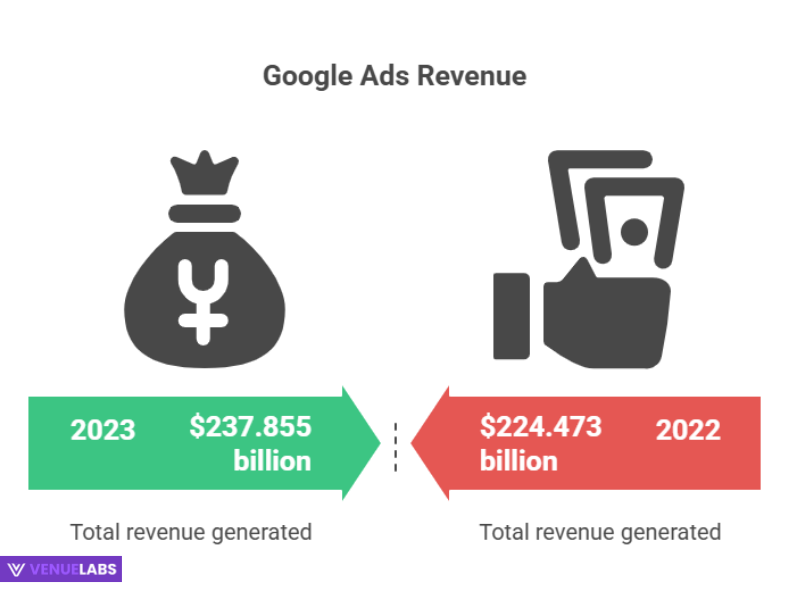
Google Ads is a massive revenue generator for its parent company, Alphabet. In 2023, Google Ads generated a total revenue of $237.855 billion.
This figure represents significant growth, increasing from $224.473 billion in 2022 and $209.49 billion in 2021. Over the last decade, Google’s ad revenue has increased by an astounding 365.74%, a clear sign of healthy and sustained growth driven by increasing internet user preferences for Google Search.
Google Ads Revenue Over the Years
| Year | Google Ads Revenue |
| 2023 | $237.855 billion |
| 2022 | $224.47 billion |
| 2021 | $209.49 billion |
| 2020 | $146.92 billion |
| 2019 | $134.81 billion |
| 2018 | $116.46 billion |
| 2017 | $95.58 billion |
| 2016 | $79.38 billion |
| 2015 | $67.39 billion |
| 2014 | $59.62 billion |
| 2013 | $51.07 billion |
2. Cost of Google Ads (CPC)
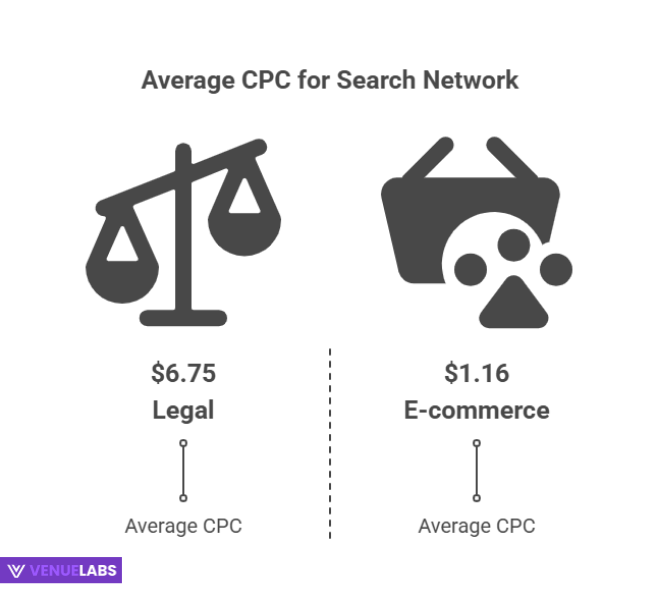
The average cost per click (CPC) for Google Ads is $4.22. However, this average varies considerably across industries, reflecting competition and conversion value.
Average CPC for Search and Display Networks by Industry
| Industry | Average CPC for Search Network | Average CPC from Display Network |
| Dating and Personals | $2.78 | $1.49 |
| Finance and Insurance | $3.44 | $0.86 |
| B2B | $3.33 | $0.79 |
| Consumer Services | $6.40 | $0.81 |
| Advocacy | $1.43 | $0.62 |
| Auto | $2.46 | $0.58 |
| Legal | $6.75 | $0.72 |
| Travel and Hospitality | $1.53 | $0.44 |
| Industrial Services | $2.56 | $0.54 |
| E-commerce | $1.16 | $0.45 |
| Education | $2.40 | $0.47 |
| Employment Services | $2.04 | $0.78 |
| Technology | $3.80 | $0.51 |
| Health and Medical | $2.62 | $0.63 |
| Home Goods | $2.94 | $0.60 |
| Real Estate | $2.37 | $0.75 |
Industries like Legal and Consumer Services often have higher CPCs due to the high value of a conversion, while E-commerce and Travel & Hospitality generally see lower CPCs.
Beyond CPC, businesses typically spend between $1,000 and $10,000 per month on Google Ads campaigns. If they use a PPC management agency, costs can range from $501 to $3,000 per month on average, or 12-30% of ad spend.
PPC Management Agency Costs
| Cost Businesses Pay To PPC Management Agencies | Percentage Of Businesses |
| Less than $100 | 3% |
| $100 to $500 | 12.1% |
| $501 to $1000 | 15.2% |
| $1001 to $3,000 | 21.2% |
| $3001 to $5000 | 12.1%c |
| $5001 to $8000 | 15.2% |
| $8001 to $11,000 | 9.1% |
| $11,001 to $15,000 | 7.6% |
| More than $15,000 | 4.5% |
3. Return on Investment (ROI)
The average return on investment for businesses using Google Ads is $2 for every $1 spent, which is a 200% ROI. However, for optimized campaigns, this can be much higher, reaching up to $8 for every dollar in some industries. This strong ROI makes Google Ads a highly attractive investment for driving business growth.
Google Ad Networks and Formats: At a Glance 2025
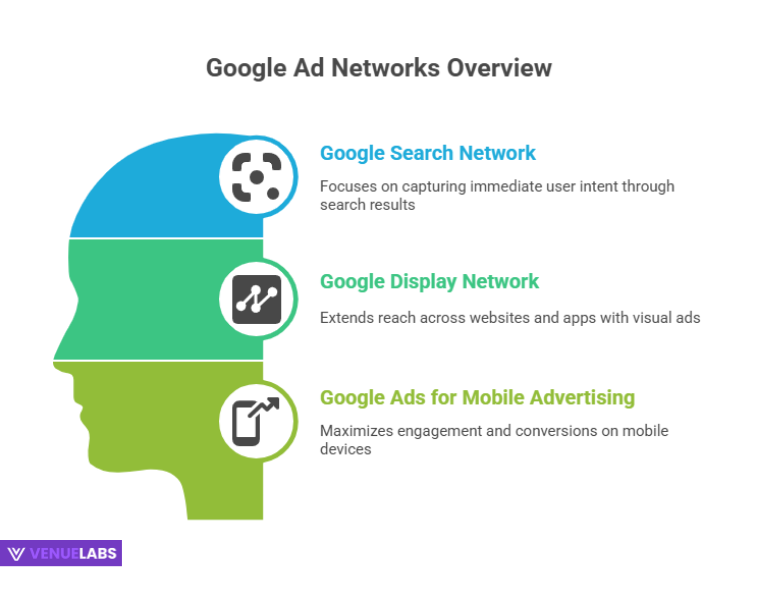
| Feature / Network | Google Search Network | Google Display Network (GDN) | Google Ads for Mobile Advertising |
| Description | Shows ads directly in Google search results, targeting users with active intent. | Extends reach across millions of websites, apps, and YouTube with visual ads. | Focuses on ad performance and user interaction specifically on mobile devices. |
| Primary Goal | Capture immediate intent, drive conversions. | Brand awareness, remarketing, broad reach. | Maximize engagement and conversions for mobile users. |
| Average Conversion Rate | 6% | 0% to 1% | See notes on Mobile Clicks & Effectiveness |
| User Clicks / Engagement | 63% of people click on paid ads in search results. | Average CTR of 35%. | 63% of all Google ad clicks originate from mobile devices (some reports say 95% of paid clicks). |
| Types of Ads Available | 6 types (e.g., text, call ads). | 8 types (e.g., image, rich media, video). | Responsive Ads are highly favored (84% of businesses). |
| User Preference | 55% of users prefer Search Network text ads. | 55% of companies use display ads. | Mobile ads are 5x more effective than other online ads. |
| Overall CTR | An impressive 91% (for the network). | 35% | Implicit in Mobile Clicks, varies by ad type. |
| Average CPC | Varies significantly by industry (typically higher due to intent). | $1 or less (often lower than Search Network). | Implicit in overall Google Ads CPC, varies by format. |
| Reach | Targets users on Google Search, Google Shopping, and other Google sites. | Reaches 90% of online consumers, serving 2+ trillion impressions monthly to 2.5+ billion users across 2M+ websites and in-network apps. | 64% of all mobile searches occur on Google. |
| Brand Awareness Impact | Primarily conversion-focused, but builds awareness over time. | Significant for brand visibility and recall. | Increases brand awareness by 46%. |
| Direct Contact Feature | Implicit with call ads, but less emphasized. | Less direct, more visual engagement. | 60% of smartphone users contact businesses directly via search features (e.g., click-to-call). |
| Ad Spend Allocation | Typically a larger portion of PPC budget due to high intent. | Often used for supplemental reach and remarketing budgets. | Approximately 33% of mobile ad spending goes to Google Ads. |
Google AdSense: Earning Through Content
For publishers and website owners, Google AdSense provides a way to monetize their content by displaying relevant Google Ads.
AdSense Revenue Potential
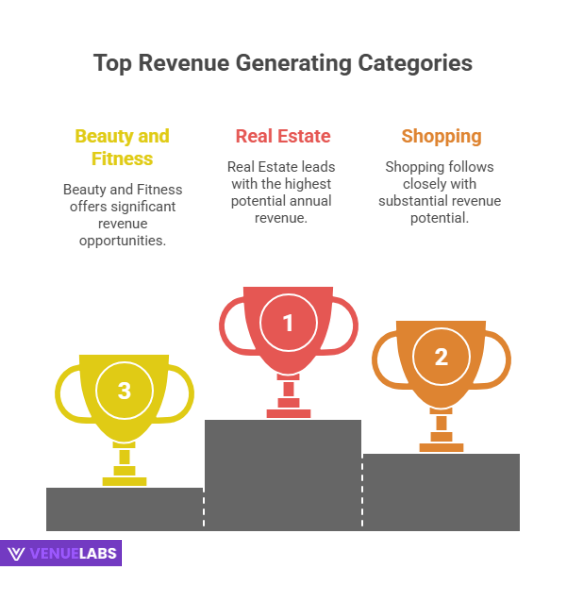
Google AdSense typically pays between $0.2 and $2.5 per 1,000 views.
However, this payout varies significantly based on factors like:
- Content Niche: Different industries have different ad values.
- User Location: Geolocation of users impacts ad rates.
- Time on Site: Longer engagement often leads to better ad performance.
- Device Breakdown: Mobile versus desktop traffic can yield different returns.
Google states that the publisher revenue share for AdSense for content is 68%, meaning publishers keep a significant portion of the ad revenue generated on their sites.
Potential Annual Revenue on Google Ads through Monthly Page Views
| Monthly Page Views | Arts And Entertainment | Beauty And Fitness | Shopping | Real Estate |
| 1 million | $67,000 | $156,000 | $168,000 | $178,000 |
| 2 million | $137,000 | $317,000 | $337,000 | $353,000 |
| 3 million | $203,000 | $470,000 | $506,000 | $528,000 |
| 4 million | $271,000 | $627,000 | $675,000 | $699,000 |
| 5 million | $337,000 | $780,000 | $840,000 | $870,000 |
Google Ads Statistics and Trends for 2025
The digital advertising landscape is always evolving, and Google Ads is at the forefront of these changes. Several key trends are shaping the future of the platform in 2025.
Key Trends and Predictions
- Increased Marketing Spending: 94% of small businesses plan to increase their marketing spending, with a significant portion allocated to digital channels like Google Ads.
- Growing Revenue: Google Ads revenue is expected to reach $81 billion, a testament to its continued growth and importance.
- Widespread Adoption: Over 84% of advertisers either already use or plan to use Google Ads, highlighting its essential role in marketing strategies.
- Voice Search Optimization: With the rise of digital voice assistants, optimizing Google Ads for voice search will become increasingly prevalent. This means focusing on natural language queries and conversational keywords.
- AI Integration: Many businesses will embrace the usage of AI in their Google Ads strategies, leveraging machine learning for automated bidding, audience targeting, and creative optimization.
- First-Party Data Reliance: Google plans to phase out third-party cookies by Q3 2024. This will force advertisers to rely more heavily on their own first-party data for targeting and measurement, making customer relationship management (CRM) and data collection strategies more critical than ever.
- Enhanced Ad Recall: Including a voice-over in Google ads can increase ad recall by 25% and lower the cost per lifted user by 50% compared to regular advertisements. This highlights the power of multi-sensory advertising.
What These Google Ads Statistics Mean for Advertisers
Looking at numbers is one thing; making sense of them for your specific business is what truly matters. These statistics provide critical benchmarks and actionable insights.
- Benchmark Your Performance: If your campaigns are not meeting the average CTR (around 6.6%) or conversion rates (closer to 7.5%), you have clear opportunities for improvement. Refine your targeting, refresh your ad copy, and optimize your landing pages.
- Cost vs. Value: While the average CPC sits around $2.69 globally, do not just focus on the cost. Instead, evaluate whether those clicks are turning into profitable revenue. A higher CPC is acceptable if it leads to a significantly higher return.
- Google’s Enduring Dominance: With a nearly 90% search market share, Google remains the primary platform for intent-driven traffic. Shifting significant budgets to smaller ad networks without a clear strategy might mean missing out on your most engaged audience.
- Optimizing for ROI: The average 2:1 ROI is steady, but the potential for 8:1 or higher shows that dedicated optimization efforts can lead to substantial gains. Continuously test, analyze, and refine your campaigns.
Actionable Tips Based on 2025 Google Ads Data
How do you translate these statistics into real-world success for your business? Here are some practical steps:
- Craft Irresistible Ad Copy: The top three paid results grab nearly half of all paid clicks. Focus on creating compelling, clear, and benefit-driven ad copy. Utilize ad extensions, strong calls-to-action (CTAs), and relevant keywords to stand out.
- Prioritize Quality Score to Reduce CPC: Instead of just adjusting bids, improve your Quality Score. This involves ensuring high ad relevance to your keywords, excellent landing page experience, and a strong expected CTR. Better Quality Scores lead to lower CPCs and higher ad positions.
- Embrace a Mobile-First Mindset: With over half of all clicks coming from mobile devices, your mobile experience must be flawless. Ensure fast-loading landing pages, responsive design, easy navigation, and simplified conversion paths (e.g., one-click checkout).
- Leverage Google Shopping Ads for E-commerce: If you sell physical products, Google Shopping Ads are non-negotiable. They account for the vast majority of retail ad spend and clicks. Make sure your product feeds are optimized and you are actively running Shopping campaigns.
- Relentlessly Track and Analyze ROI: Do not just look at clicks and impressions. Implement robust conversion tracking to understand your true return on investment. A/B test different ad creatives, bidding strategies, and landing pages to see what truly drives your business goals.
- Explore AI and Automation: Google’s Performance Max campaigns and other automated features can save time and improve performance. Use these tools, but combine them with your own data analysis to ensure they align with your specific objectives.
- Prepare for a Cookie-less Future: Start building your first-party data strategies now. Implement enhanced conversion tracking, nurture email lists, and utilize customer data platforms to gather and leverage your own customer information for targeted and personalized marketing.
What Users are Asking: Insights from Quora and Reddit (Latest Information)
Beyond the standard statistics, online communities like Quora and Reddit offer a pulse on what advertisers and businesses are truly curious about. Here are some trending questions and insights for 2025:
- “Is Google Ads becoming too expensive for small businesses?”
- Insight: Many users express concern over rising CPCs, especially in competitive niches. While costs can be a factor, the data shows that 65% of small and mid-sized businesses still find value. The key isn’t necessarily lower costs, but higher ROI. Small businesses are looking for ways to maximize every dollar by hyper-targeting, focusing on long-tail keywords, and improving landing page conversion rates. They are asking about strategies to compete without breaking the bank.
- “How do I deal with ad fraud and invalid clicks on Google Ads?”
- Insight: Ad fraud is a persistent concern. Users are asking about best practices for identifying suspicious activity, understanding Google’s invalid click detection, and third-party tools to protect their ad spend. This highlights a need for greater transparency and tools to combat bot traffic and competitor sabotage.
- “What’s the best way to leverage AI in Google Ads without losing control?”
- Insight: The rise of AI-driven automation (like Performance Max) is a hot topic. Advertisers appreciate the time-saving benefits but worry about the “black box” nature of these campaigns. They are seeking advice on how to guide AI, set smart guardrails, interpret automated results, and ensure alignment with their brand strategy, rather than blindly trusting the algorithms.
- “How important is a good landing page for Google Ads in 2025?”
- Insight: Users increasingly understand that clicks alone are not enough. There’s a strong emphasis on the post-click experience. Questions revolve around landing page best practices for different industries, mobile optimization, A/B testing tools, and how landing page quality impacts Quality Score and conversion rates.
- “Given the deprecation of third-party cookies, what are the most effective targeting strategies now?”
- Insight: This is a major area of discussion. Advertisers are actively seeking alternatives for audience targeting. They are asking about first-party data strategies, contextual targeting, Google’s FLoC (Federated Learning of Cohorts) or Topics API, and other privacy-centric methods to reach their audience effectively in a post-cookie world.
These real-world questions from online communities show that while the core value of Google Ads remains, advertisers are constantly seeking smarter, more efficient, and future-proof ways to leverage the platform.
FAQs About Google Ads Statistics
1. How much ROI can I realistically expect from Google Ads in 2025?
You can realistically expect an average ROI of $2 for every $1 spent on Google Ads, which translates to a 200% return; however, with highly optimized campaigns that target specific keywords and audiences, you can achieve a much higher ROI, often reaching up to $8 for every dollar invested.
2. Is Google Ads still worth it for small businesses, given the rising costs?
Yes, Google Ads absolutely remains worth it for small businesses in 2025 because it provides highly targeted traffic with strong purchase intent, and 65% of small to mid-sized businesses already utilize it to their benefit, proving its ongoing value. The key for small businesses is to focus on niche targeting, excellent ad copy, and continuous optimization to maximize their budget and achieve a strong return on investment.
3. What is the most effective type of Google Ad for e-commerce businesses?
For e-commerce businesses, Google Shopping Ads are by far the most effective type of ad because they dominate retail search ad spend, account for 85.3% of all clicks on Google Ads for shopping, and display products directly with images, prices, and merchant information, which directly influences purchase decisions.
4. How will the phasing out of third-party cookies affect Google Ads targeting in 2025?
The phasing out of third-party cookies by Q3 2024 will significantly shift Google Ads targeting in 2025, requiring advertisers to rely more heavily on their own first-party data, contextual targeting, and Google’s privacy-centric solutions like the Topics API to reach relevant audiences effectively. This means you need to prioritize collecting and leveraging your customer data.
5. How much time should I dedicate to managing my Google Ads campaigns each week?
You should dedicate an average of 30 minutes to an hour per week to actively adjusting keywords, refining campaign settings, analyzing performance results, and implementing strategic changes to ensure your Google Ads campaigns remain optimized and efficient. Consistent monitoring and optimization are crucial for achieving the best results.
Also Read:
- Latest Digital Marketing Statistics
- Affiliate Marketing Statistics
- Video Marketing Statistics
- Email Marketing Statistics
- PayPal Statistics
Conclusion:
Google Ads clearly stands as the global leader in PPC advertising for 2025, consistently delivering unmatched reach, engagement, and return on investment.
With a staggering 80.20% market share and 96% of brands actively investing in its campaigns, its importance cannot be overstated.
Mobile devices now account for 61.9% of all Google Ads clicks, and the platform generates annual revenues topping $237.9 billion, unequivocally demonstrating its power to drive business growth at scale.
While costs per click may vary, typically ranging from $1.16 to $6.75, the substantial returns make Google Ads a worthwhile investment for almost any business. Particularly compelling are the conversion rates, which consistently outperform organic traffic by a significant 50%, highlighting the high intent and value of paid ad clicks.
Suppose your business aims to effectively capture new customers, expand your online visibility, and maximize your advertising ROI. In that case, Google Ads remains the smartest and most reliable investment in digital marketing today. Embrace the data, optimize your campaigns, and prepare to unlock unparalleled growth.
